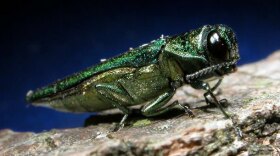The Emerald Ash Borer, an invasive Asian beetle that has decimated American ash trees in the United States has been in the city of Boulder between three and four years according to the results of a new study conducted by a collaborative EAB incident command team.
“It doesn’t spread very far on its own,” said John Kaltenbach, state survey coordinator for the Colorado Department of Agriculture. “Most of its big jumps are human assisted. It probably showed up in Boulder on firewood or something else that somebody brought in from the Midwest.”
Boulder is the only place in Colorado where the beetle has been found.
The delimitation survey conducted in the fall of 2013 uncovered the extent of the infestation. Boulder was divided into 38 grids, each 1 square mile. Crews then removed and stripped 2 branches from 10 trees sampled in each grid to see if the beetle is present.
“That it took us four years to detect it is not surprising. It is a very difficult insect to detect and that’s one of the things that makes it very problematic,” said Kaltenbach, adding that it was really just a matter of time.

“We’ve been talking about EAB for a number of years because we figured it would eventually show up here because it’s been spreading through the Midwest," Kaltenbach said. "A lot of our front range cities have already sort of been in the planning stages but we all felt like we might have had another year or two and that we found it in Boulder and that it’s already been here for a couple years that really increased the efforts to look for it.”
He says that public outreach is very important, since it would vastly increase the number of people looking for EAB.
What Makes Colorado Different?
Containment of EAB has proven impossible in the Midwest, primarily because of their contiguous ash forests – which Colorado doesn’t have.
Whitney Cranshaw, a professor of entomology at Colorado State University, stresses the importance of quarantines.
“EAB is always one truck load away. We have a much more geographically compartmentalized state than any other place where EAB has happened. So for it to get to Carbondale, someone has to take it to Carbondale,” Cranshaw said.
"There are about 4,800 ash trees in Boulder."
The goal of the quarantine is to limit the amount of material of untreated ash products like firewood that can move Emerald Ash Borer out of Boulder County.
“We’re going on what we know. We’re going to try to contain it in Boulder. We may find it somewhere else down the line, and then we’d have to change what we’re doing, but for now we’ve put a quarantine on the county of Boulder,” Kaltenbach said.
EAB was first detected in Boulder in September 2013. It can infest an ash tree for up to four years before any visible signs are detected.
The state department of agriculture enacted an emergency quarantine last fall to prevent untreated ash tree products and nursery stock from leaving Boulder County because of the Emerald Ash Borer. That quarantine has now become official and indefinite.
The quarantine prohibits the movement of all untreated plants and plant parts of the genus Fraxinus out of the quarantined area. This includes, but is not limited to:
- Logs and green lumber
- Nursery stock, scion wood, and bud wood
- Chips and mulch, either composted or uncomposted
- Stumps, roots and branches
- Firewood of any non-coniferous (hardwood) species
The City of Boulder is coming up with a management plan that must be approved by the city council. There are about 4,800 ash trees in Boulder.
Kaltenbach says cities in the Midwest that have dealt with Emerald Ash Borer advocate treatment of some ash trees in order to delay the death and subsequent removal cost of all the trees at once.
Native to Asia, this is the first appearance of the insect in Colorado. It has killed over 50 million ash trees since its initial discovery in Michigan in 2002.
According to the Colorado Department of Agriculture, infestation signs include:
- Sparse leaves or branches in the upper part of the tree
- D-shaped exit holes about 1/8 inch wide
- New sprouts on the lower trunk or lower branches
- Vertical splits in the bark
- Winding S-shaped tunnels under the bark
- Increased woodpecker activity




